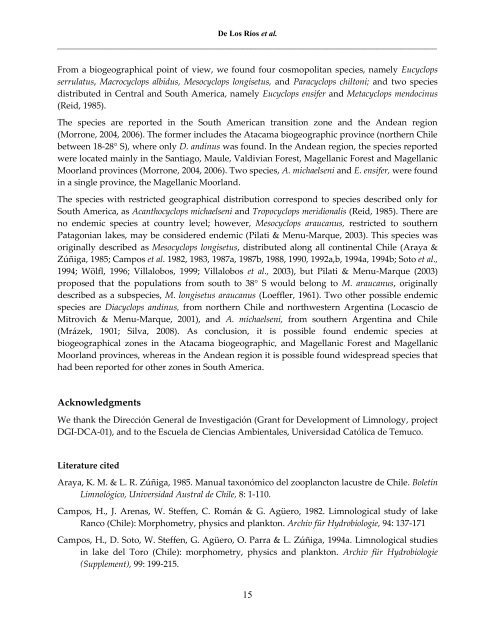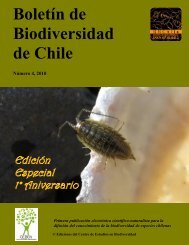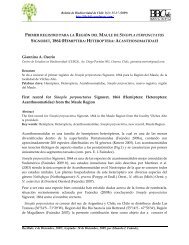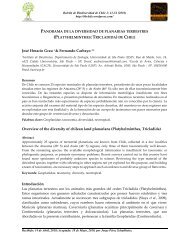PDF - boletÃn de biodiversidad de chile
PDF - boletÃn de biodiversidad de chile
PDF - boletÃn de biodiversidad de chile
Create successful ePaper yourself
Turn your PDF publications into a flip-book with our unique Google optimized e-Paper software.
De Los Ríos et al.<br />
______________________________________________________________________________________________<br />
From a biogeographical point of view, we found four cosmopolitan species, namely Eucyclops<br />
serrulatus, Macrocyclops albidus, Mesocyclops longisetus, and Paracyclops chiltoni; and two species<br />
distributed in Central and South America, namely Eucyclops ensifer and Metacyclops mendocinus<br />
(Reid, 1985).<br />
The species are reported in the South American transition zone and the An<strong>de</strong>an region<br />
(Morrone, 2004, 2006). The former inclu<strong>de</strong>s the Atacama biogeographic province (northern Chile<br />
between 18-28° S), where only D. andinus was found. In the An<strong>de</strong>an region, the species reported<br />
were located mainly in the Santiago, Maule, Valdivian Forest, Magellanic Forest and Magellanic<br />
Moorland provinces (Morrone, 2004, 2006). Two species, A. michaelseni and E. ensifer, were found<br />
in a single province, the Magellanic Moorland.<br />
The species with restricted geographical distribution correspond to species <strong>de</strong>scribed only for<br />
South America, as Acanthocyclops michaelseni and Tropocyclops meridionalis (Reid, 1985). There are<br />
no en<strong>de</strong>mic species at country level; however, Mesocyclops araucanus, restricted to southern<br />
Patagonian lakes, may be consi<strong>de</strong>red en<strong>de</strong>mic (Pilati & Menu-Marque, 2003). This species was<br />
originally <strong>de</strong>scribed as Mesocyclops longisetus, distributed along all continental Chile (Araya &<br />
Zúñiga, 1985; Campos et al. 1982, 1983, 1987a, 1987b, 1988, 1990, 1992a,b, 1994a, 1994b; Soto et al.,<br />
1994; Wölfl, 1996; Villalobos, 1999; Villalobos et al., 2003), but Pilati & Menu-Marque (2003)<br />
proposed that the populations from south to 38° S would belong to M. araucanus, originally<br />
<strong>de</strong>scribed as a subspecies, M. longisetus araucanus (Loeffler, 1961). Two other possible en<strong>de</strong>mic<br />
species are Diacyclops andinus, from northern Chile and northwestern Argentina (Locascio <strong>de</strong><br />
Mitrovich & Menu-Marque, 2001), and A. michaelseni, from southern Argentina and Chile<br />
(Mrázek, 1901; Silva, 2008). As conclusion, it is possible found en<strong>de</strong>mic species at<br />
biogeographical zones in the Atacama biogeographic, and Magellanic Forest and Magellanic<br />
Moorland provinces, whereas in the An<strong>de</strong>an region it is possible found wi<strong>de</strong>spread species that<br />
had been reported for other zones in South America.<br />
Acknowledgments<br />
We thank the Dirección General <strong>de</strong> Investigación (Grant for Development of Limnology, project<br />
DGI-DCA-01), and to the Escuela <strong>de</strong> Ciencias Ambientales, Universidad Católica <strong>de</strong> Temuco.<br />
Literature cited<br />
Araya, K. M. & L. R. Zúñiga, 1985. Manual taxonómico <strong>de</strong>l zooplancton lacustre <strong>de</strong> Chile. Boletín<br />
Limnológico, Universidad Austral <strong>de</strong> Chile, 8: 1-110.<br />
Campos, H., J. Arenas, W. Steffen, C. Román & G. Agüero, 1982. Limnological study of lake<br />
Ranco (Chile): Morphometry, physics and plankton. Archiv für Hydrobiologie, 94: 137-171<br />
Campos, H., D. Soto, W. Steffen, G. Agüero, O. Parra & L. Zúñiga, 1994a. Limnological studies<br />
in lake <strong>de</strong>l Toro (Chile): morphometry, physics and plankton. Archiv für Hydrobiologie<br />
(Supplement), 99: 199-215.<br />
15








